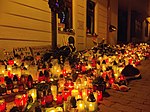Bratislava Castle
15th-century architecture in Slovakia15th-century fortifications9th-century architecture in Slovakia9th-century fortificationsBoii ... and 7 more
Buildings and structures completed in 1434Buildings and structures completed in 1964Buildings and structures in BratislavaCastles in SlovakiaGreat MoraviaHistory of BratislavaTourist attractions in Bratislava

Bratislava Castle (Slovak: Bratislavský hrad, IPA: [ˈbracislawskiː ˈɦrat] (listen); German: Pressburger Burg; Hungarian: Pozsonyi vár) is the main castle of Bratislava, the capital of Slovakia. The massive rectangular building with four corner towers stands on an isolated rocky hill of the Little Carpathians directly above the Danube river in the middle of Bratislava. Because of its size and location, it has been a dominant feature of the city for centuries. The location provides excellent views of Bratislava, Austria and, in clear weather, parts of Hungary. Many legends are connected with the history of the castle.
Excerpt from the Wikipedia article Bratislava Castle (License: CC BY-SA 3.0, Authors, Images).Bratislava Castle
Burghof, Bratislava Bratislava (District of Bratislava I)
Geographical coordinates (GPS) Address Nearby Places Show on map
Geographical coordinates (GPS)
| Latitude | Longitude |
|---|---|
| N 48.142222222222 ° | E 17.1 ° |
Address
Burghof
811 01 Bratislava, Bratislava (District of Bratislava I)
Region of Bratislava, Slovakia
Open on Google Maps











